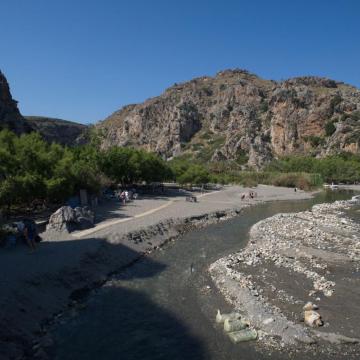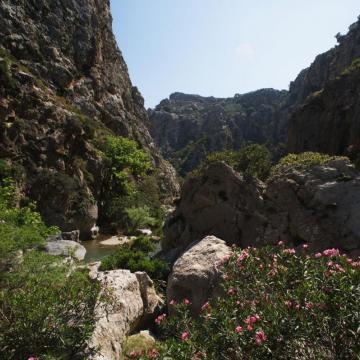GR4330003 - KOURTALIOTIKO FARANGI - MONI PREVELI - EVRYTERI PERIOCHI
Map
Quality
The gorge of Kourtaliotis, including the surrounding area and the estuary, is a place comprising a rare and unique natural beauty with a great biological diversity which make it a place of great, ecological and aesthetic importance at the level of Crete and of the Mediterranean.In particular, the main elements of its quality and importance are:1) The Phoenix theophrastii forest, the second (after Vai) largest natural palm forest in Crete.Moreover, P. theophrastii is one of the only two native palm species in Europe.2) The variety of biotopes, with well structured vegetation at a good general conservation status reaching at an almost climax condition at places. This results in the high degree of biodiversity that characterizes the site and that is evident in the presence of a relatively large number of endemic species in the gorge.3) Kourtaliotis river is one of the few freshwater systems with permanent water flow in Crete.4) The presence of important bird species such as Gyps fulvus, Falco tinnunculus, Falco respectivus, and Ptyonoproque rupestris. Besides, the site is part of one of the Important Bird Areas in Europe.5) The whole area, with the old monastery of Preveli, is an historical and archaeological site.OTHER IMPORTANT SPECIES WITH MOTIVATION DThe following species are protected by the Greek Law (Presidential Decree 67/81) and are included in the IUCN Red Data List (1993) in the category of threatened plants: Biarum davisii ssp. davisii (rare), Ferulago thyrsiflora (rare), Sesleria doerfleri (rare).Tulipa saxatilis is protected by the Greek Law (Presidential Decree 67/81).Lactuca acanthifolia (= Scariola acanthifolia) is found in Ydra, Cyclades, East Aegean Islands andonly in SW Turkey out of Greece. Allium callimischon ssp. haemostictum is a plant with distribution in Greece and SW Turkey. Brassica cretica ssp. cretica is a chasmophyte occurring only in C. and S. Lebanon out of Greece.
Other characteristics
The site, at the southern central Crete, includes the gorge of Kourtaliotis river, a narrow river with permanent water supply, which cuts through the gorge, flowing down a rocky bed, to end up to a small cove, with a sandy beach, 250 m in length and 60-70 m in width. At the estuary, a small pond with brackish is formed, in the middle of the beach, 10 m from the sea.The water from the springs of Agios Nikolas, middleway in the gorge, is collected by a water lock which supplies water to all the villages around.The main types of biotopes that characterize the site are: rock faces with characterizing chasmophytic vegetation and phrygana, at the slopes of the gorge; riparian arborescent vegetation with Phoenix theophrastii, Nerium oleander, Ceratonia siliqua; small coastal habitas at the estuary of the river, with Vitex-agnus castus and halophytic vegetation (Juncus maritimus and Phragmites australis) and small sand dunes; sea cliff vegetation and marine habitas, with Posidonia sea bedsThe Phoenix theophrastii forest -the second most important palm forest of Phoenix in Crete, aged of several decades, extends into the gorge at a distance of at least 600 m from the beach.
Documentation
1) Kypriotakis Z. Unpublished data. [3.3.]
2) Patras University - Ministry of Environment, Physical Planning and Public Works. 1988. (Work Team: Economidou E. et al) Entopismos kai meleti ton ygroviotopon kai allon simantikon gia tin ornithopanida viotopon tis Kritis (Localization and study of wetlands and of other important for the birdfauna biotopes of Crete). Final report, Vol. 1, Patra. p. 384.
3) Kypriotakis Z. & G. Tsiourlis. Vegetation map of Crete. Unpublished data.
4) Prefecture of Rethimno. 1986. Eisigitiki ekthesi gia tin axiopoiisi tis liminis Preveli (Intoductory report for the development of teh lake of Preveli).
5) Georghiou K. 1995. Checklist of Endemic, Rare and Threatened Plants of Greece. Draft. University of Athens. (3.3, 3.4, 4.2)
6) Morgan V & C. Leon. 1992. Datasheets of Flora species for revision of Appendix I of the Bern Convention. Volume IV. endemic taxa of Cyprus, Greece and Turkey Nature and environment. Nature and Envrionment. No 63 p. 106. Council of Europe, Publishing and Documentaion Service, Strasbourg. (3.2.g.)
Reference: Natura 2000 data form, database release 7 Feb 2014




